|
Taking
place in Holland just before the turn of
the last century, our film opens with Hans
von Arnam (Pierre
Brice) boarding a ferry that will
take him across the fog enshrouded canals
to the windmill abode of Professor
Gregorius Wahl, which also houses the
eccentric artists' Carousel of Stone
Women ... Kind of a screwed-up version of
Walt Disney's It's a Small, Small World
attraction, the Carousel is an intricate
array of massive gears and pulleys that
operate a macabre animated display of
famous and infamous women -- and only
women, he typed ominously -- posed at the
moment of their demise: Joan
of Arc at the stake; Marie Antoinette on
the chopping block etc. etc.
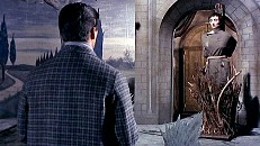
Shows
at 4:00 and 4:30, and 2:00 matinees on
Saturdays. Senior Citizens half-price.
Kids under five admitted for free.
The
actual purpose of Arnam's visit is a
little murky, but I believe he's there to
write an article about this quirky landmark (--
and is Holland's tourist industry this
desperate?). After meeting with
Wahl (Wolfgang
Preiss),
who graciously offers all kinds of
background material for the expose, Arnam
gets to work, but as he tries to put pen
to paper, he is constantly distracted
by a beautiful girl, whom he keeps catching
fleeting glimpses of ever since he
arrived. This terminally shy girl is
Elfie (Scillia Gabel),
Wahl's daughter, and as Arnam tries to
learn more about her, he is gently told
"hands off" by Wahl, and then
not-so-gently told "hands off"
by Dr. Bolem (Herbert
Böhme),
her in-house physician. You see, Elfie has
inherited a strange condition where any
kind of emotional distress can prove
lethal. The very same malady claimed Dr.
Wahl's wife and that's why the girl can
never leave the mill, and under no
circumstances can Elfie be
... well, aroused.
Already
trying to salvage a relationship with his
current girlfriend, Lisolette Kornheim (Danny
Carrel), things
are getting pretty complicated for poor
Arnam as
he's completely smitten with the
mysterious and fragile girl. And things
get even more complicated when Elfie
sneaks in a few visits with him; for it
appears she's smitten, too, and they clandestinely
arrange a late night rendezvous -- if you
know what I mean, and I think you do. When
Elfie survives
this illicit encounter intact, it makes
Arnam wonder if Wahl's story is a load of
bull, and if Elfie's being held in the
mill against her will. But before he can
investigate further, however, Lisolette
and his best friend, Raab (Marco
Guglielmi), both art students of
Wahl's at the local university, stop by
for a visit. Here, Arnam realizes that
Lisolette is the one he truly loves and
wants to marry. But how does he break this
news to Elfie?
Given
the bad news during another one of her
late night visits, this jilting definitely
qualifies as emotional distress for Elfie
... Turning a deathly shade of pale, her
condition rapidly deteriorates into spasm,
then full seizure, and then total
collapse. Arnam -- who really is kind of a
turd of a hero -- panics, scoops her up,
and takes the limp form back to her room.
Laying her on the bed, he notices her face
landed near a hand mirror -- that's not
fogging up, meaning she's not breathing,
which means Elfie is dead. Our
"hero" panics, again, and
then clears off the premises as fast as
his feet will take him.
Like
I said, turd...
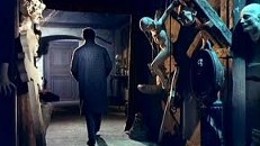
God
bless the fine folks over at Eccentric
Cinema. I've been trolling around
over there for awhile now, and you really
should, too, unearthing all kinds of
strange and oddball films that I'd never
seen before -- or really even heard of --
but are now finally getting out on DVD.
It's been murder on my bank account, but
I've tracked down a half-dozen or so of
these titles that piqued my interest --
none of them stranger, or more oddball for
that matter, than Georgio Ferroni's Mill
of the Stone Women.
An
Italian and French co-production, set in
Holland, using mostly German actors (--
Preiss would go on to play the equally mad
Dr. Mabuse for Fritz Lang --), the
film was based on a short story of the
same name by writer Pieter Van Weigen,
collected in a book called Flemish
Tales.
Based on Scandinavian folklore, Van
Wiegen's story centered on how the native
windmills represented three distinctly
different levels: Heaven, Earth and Hell.
Sure, whatever. That's thinking a little
too deeply here, though, and it took
Ferroni and three other -- that's four,
count 'em four -- scriptwriters to
cook it into a script as demented as this.
One
part Grimm's Fairy Tale, one part Edgar
Wallace murder mystery, and then mixed with a
little Mystery
of The Wax Museum,
the end results are a strange concoction
that's long on mood and atmosphere, with
plenty of strange characters and morbid
plot twists to keep things humming right
along until the real whiz-banger of a
climax.
So
what's really going on at Professor Wahl's
old windmill? Lets find out, shall we?
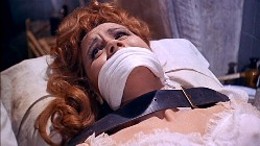
(She'd
tell you, but she's all tied up at the
moment. Mmwahahaahah...)
Anyhoo
... As the guilt gnaws away at our so-called
hero, Arnam returns to the mill and sneaks
into Elfie's bedroom -- but she's not
there. In fact, judging by all the dust
and cobwebs, the room appears to have been
unoccupied for a very long time. Baffled
by this, Arnam tries to sort it out and
looks for some answers. When he runs into
Bolem -- who sees the young man is
terribly upset about something -- the
doctor offers Arnam a sedative to calm him
down. Then things get curiouser and
curiouser as Bolem's sedative triggers a
long, phantasmagorical nightmare sequence
for Arnam: while the ghost of Elfie haunts
and taunts him, Wahl berates him for not
listening and heaps on the blame for
causing his daughter's demise. This
night-terror concludes with Arnam running
about the mill, in a futile attempt to
escape his guilt, and eventually, into the
family crypt, where he desecrates Elfie's
grave by opening it up. Sure enough, her
body's in there. Our boy quickly retreats,
and as a dazed Arnam continues to wander
aimlessly around the mill, he hears a
woman's haunted screams. Following the
cries down into the mill's sub-levels, through
an open door, he
spies Amilore (Liana
Orfei -- last seen tormenting Hercules,
Samson & Ulysses), a
model who poses for Wahl's art classes,
tied to a chair. The door slams shut
before he can get to her, though, and it
won't budge. As Arnam pounds on the door,
trying to get in, Bolem comes on scene
wanting to know what all the ruckus is
about. Told what the boy saw, Bolem is
incredulous but unlocks the door anyway.
The room is empty.
Fearing
he's losing his sanity, Arnam demands to
speak to Wahl. Bolem complies, and when
the boy spills his guts and confesses to killing
Elfie, Wahl doesn't seem too shocked by
this news -- no, he thinks it's a pretty
sick joke. Though Bolem assures him that
Elfie is fine, Arnam insists he just saw
her entombed and she was most definitely
dead. Worried about the lad's mental
state, the elder men say that's nonsense,
and to prove it, Wahl calls for Elfie, who
appears at the top of the steps, alive and
well. Obviously, Arnam's
circuits are a little fried by this
development. Wahl, meanwhile, says he's willing to
forget the whole thing, but Arnam will
have to pack up and clear out immediately.
And as he escorts him off the premises,
Wahl strongly urges the vanquished Arnam to
seek some professional help. But after
he's gone, things take another sinister
turn as Bolem thinks they should have just
killed the interloper because Elfie has fallen in
love with him. But Wahl assures that over
time, she will forget him and Arnam is no
longer a threat: their little drug-induced
acid trip has seen to that. Still, Bolem
worries that Arnam might come back and
find out that Elfie's been dying for years,
and how they must constantly restore her
to life.
...What
the hell goes on here, you ask?
Well,
we get our answer PDQ, as Wahl and Bolem
reveal the true nature of their treachery.
You see, Elfie really does have a
sickness: a rare blood disorder that
requires a full-body blood-transfusion
every 3000 miles. And Bolem has perfected
a procedure to accomplish this and keep
her alive. Of course, to also accomplish
this, they need a live donor. Lots of
donors, actually. And if you're thinking
what I'm thinking, that all those gruesome
displays on the Carousel are actually
concealing the bodies of all the previous
donors, you get a cookie.
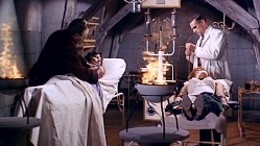
So
down into the bowels of the mill we go,
where we find a bona fide mad scientist
lair. And while Bolem prepares Elfie for
the next transfusion, Wahl straps the
struggling Amilore to a gurney. Hooking up
both women to some kind of fancy Rube
Goldbergian contraption, it first drains
all the bad blood out of Elfie, then sucks
all the good blood out of the unwilling
Amilore, and then transfers it into Elfie.
Of course, the donor kind of gets the
short shrift here.
Once
the procedure is complete, while Elfie
recovers, Wahl sets to work converting
Amilore's body into another one of his macabre
display pieces. Seems he's got some kind of
serum that freezes the body, but with a
little effort, is still malleable to
pose. Snap. Crackle. Pop. Creepy.
Meanwhile, Bolem is already hard at work
looking for their next donor. (I
gather it has to be a certain blood type.)
Taking a sample of Lisolette's blood --
taken from Wahl's handkerchief that she
used after accidentally cutting herself at
the mill earlier, the doctor makes a
startling discovery: turns out Lisolette's
blood composition is so close to Elfie's
that the cure would be permanent once the
transfusion is done. Good news for the
Wahls -- bad news for Lisolette.
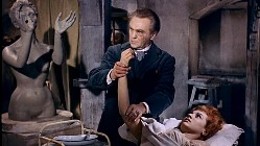
Speaking
of Lisolette, with her help, Arnam has
made a full recovery from his psychotic
episode at the mill and considers it all
just a bad dream. But when he and Raab
head to her apartment, they find her gone
-- under some mysterious circumstances,
according to the landlady. Spying a
picture of Lisolette with Amilore on the
dresser, Arnam only recognizes her as the girl
he saw trapped in Wahl's basement. But Raab
knows who it is, he and Lisolette had drawn her
hundreds of times, and wants to know where
Arnam saw her since the girl's been missing
for the past few days. As the
circumstances pile up, Arnam finally comes
clean on everything that happened to him
at the mill. After taking it all in, Raab,
who
has -- make that had -- a crush on
Amilore,
isn't quite sold, but feels it's worth
investigating. First, they check out the
crypt and find it open, but the coffin is
empty. Nearby, they spot a mannequin
poorly hidden in an alcove that looks just
like Elfie. (Obviously
one of Wahl's sculptures.)
And
any sympathy for Elfie's plight is quickly
lost in the next scene as she gloats over
the hapless Lisolette, gleefully telling
the captive how Arnam will be all hers
after she's gone. In the other room, Bolem
spouts some goobledy-gook on how his new
super-serum, when combined with
Lisolette's blood, will be a permanent
fix. But this permanent fix has a hefty
price tag: For all his years of service,
the doctor wants the bewitching Elfie for
himself after she's finally cured.

Meanwhile,
Arnam and Raab sneak into the mill and
promptly trigger the Carousel ... After it
wheezes to life, when the revolving
display gets to the last figure, Raab
recognizes the fiery red hair and tells
Arnam to stop the infernal contraption.
But when he engages the brakes, the
display comes to such a screeching
halt that the head snaps off the figure in
question, due to the momentum, and rolls
to Raab's feet. He reluctantly picks it up
for a closer look, but I think he knows
the answer already: it's Amilore. Before
this grisly revelation can even sink in,
the men hear Lisolette screaming and head
for the basement...
...Where
Wahl is currently wrassling Lisolette's
gag back on (--
and
we can't help but notice Carrel's exposed
left breast that's bursting out of her
corset. How in the hell did the censors
miss that?) With the preparations
for the last transfusion almost complete,
the two conspirators aren't really
cooperating anymore. In fact, Wahl, none
to happy about Bolem's demands, stabs the
other man to death: Elfie belongs to him
and him alone. Then,
as Arnam and Raab break through barricade
after barricade, slowly making their way
to the basement, Wahl hooks up both girls
to the infernal machine and cranks it up.
And as it begins to drain away the bad
blood from Elfie, he looks for the syringe
with Bolem's miracle additive -- but it's not
on the tray where it should be, and while
trying to find it, Wahl loses it and
trashes the lab in an ultimately futile
gesture. Grabbing Bolem's body by the
lapels of his lab coat, as Wahl furiously
shakes the body, he finally gets his answer; it
was in Bolem's pocket, where it broke open
when he fell on it after Wahl stabbed him
in the back. Hearing Arnam and Raab
getting closer, a defeated Wahl sets the
lab on fire, takes up Elfie's body, and
then slinks away, leaving Lisolette to
burn. But the boys finally manage to get
the last door broken down and rescue her
in the knick of time. Soon, the fire is
completely out of control and the trio
barely makes it outside to safety. Back
inside,
Wahl carries Elfie up as high as they can
go, but the flames aren't that far behind
them. We then cut to several shots of the
carousel burning -- each disintegrating
figure revealing what is hidden underneath
the facade. Yuck.
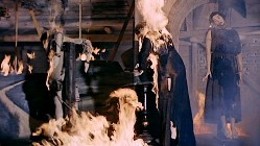
And
as Wahl raves and strokes his daughters
hair, the flames finally catch up to them.
Outside, Arnam and Lisolette, safely
embraced in each others arms, watch
solemnly as the mill burns.
The
End
If
you sit down and think about, has anyone
had more of an influence on European
cinema than mystery/adventure writer Edgar
Wallace? His intricate tales of criminal
masterminds with insane stratagems,
stalwart heroes and damsels in distress
are intertwined in everything from the James
Bond franchise to the gialli --
and most notably, the German krimis,
a Teutonic precursor to the Italian
whodunits. Mill
of the Stone Women
has not one, but two, criminal masterminds
with a stratagem that definitely qualifies
as insane; one --
well, I really wouldn't call him a
stalwart, so let's say serviceable
hero; and since we have two villains, we
have two damsels in distress -- but only
one of them gets rescued, while the other
meets a very gruesome fate.
Moving
at a very deliberate pace, it doesn't take
the viewer very long to surmise that all
the missing women are now encased in wax
-- or whatever the hell that is Wahl
injects them with to turn them into stone. The scene where he's
posing and prepping Orfei's body, with the
sound of her bones cracking as he breaks
them out of rigor while moving them
around, is the most disturbing scene in
the whole dang film. So we know the what
right away, but then the film takes its
own sweet time showing us the how
and the why. And I'll admit that I
was encouraging the film to hurry up in a
few spots, but the tedium doesn't last too
long as the film starts to unravel the
mystery, plot wise, right about the time
Arnam cracks up after his acid trip. After
that, the film abruptly switches gears
from overtly expressionistic Gothicism --
where sex and death are erotically
intertwined -- to full bore, hold onto
your seats, completely unadulterated,
maniacal mad scientist on the loose
melodrama, where damsels are menaced while
the heroes try to piece it all together --
hopefully in time to save them.
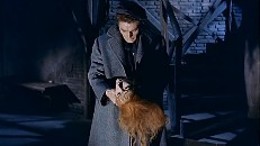
Released
the same year as Mario Bava's seminal Black
Sunday,
and while that was a moody tale of stark
black and white,
Mill
of the Stone Women
was shot in Technicolor -- but not really.
Let me explain this the best I can: the
colors are very muted and subdued,
punctuated with bright colors scattered
around the foreground, drawing the
viewer's eye all over the place. Take
a look at the screen cap of Raab holding
the dismembered head and you'll kind of
see what I'm getting at. Ferroni
uses this to great effect; dreamlike or
nightmare, depending on the situation,
adding to the films delirium as we really
can't focus our attention on just one
place. When it was originally
released, due to some print problems,
where all the color was washed out, and
compounded by one hideous dub job, the film slipped into
obscurity after it's initial theatrical
run, where it had been wallowing ever
since. But it's finally back in one piece thanks
to the fine folks over at Mondo
Macabro. With a new dub, and --
thank you jeebus -- optional subtitles,
the restored colors are crisp and clear so
we can really appreciate what Ferroni was
trying to accomplish, and Mill
of the Stone Women
should take its rightful place of honor as
one the prime examples of the horror film
renaissance of the late '50s and early
'60s.
Roger
Corman's Poe cycle, which also
debuted the same year with The
House of Usher,
received a lot of accolades for its
similar production design, use of color
and art direction --
but
a bigger nod needs to go to scriptwriter
Richard Matheson, production designer
Danny Haller and star Vincent Price. Mill
of the Stone Women
is definitely in the same vein -- only a
lot screwier,
thanks the antics of Dr. Wahl and Dr. Bolem.
And that's probably why I like Mill
of the Stone Women
better than Corman's Poe films.
Despite Vincent Price, they're almost too
gothic for their own good. (I
have the same hang-up with Hammer horror.)
Honestly,
not everything is explained away to my
satisfaction before Wahl's house of
horrors goes up in smoke, but I'm willing
to overlook it. And I encourage casual
viewers to stick with it -- at least until
the abrupt 90-degree turn from glacial
gothic-romance to manic maniacal
mad-science. You won't be disappointed.
Trust me. It's truly a very, very strange
and weird and wonderful movie. I don't
quite get it, but I likes the movie. I
likes it a lot.
|